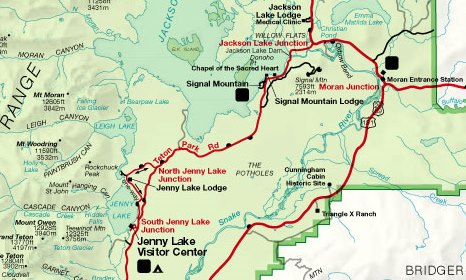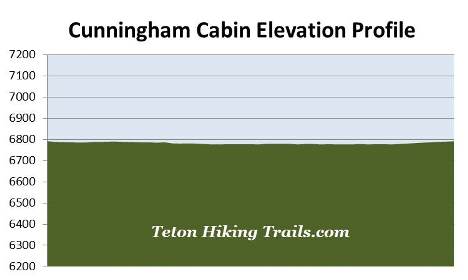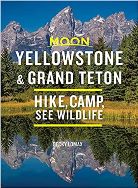
Cunningham Cabin
| Trail Features: | History, Panoramic Views | 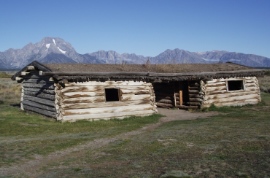 |
|||
| Trail Location: | Cunningham Cabin (South of Moran Jct.) | ||||
| Roundtrip Length: | 0.5 Miles | ||||
| Trailhead Elevation: | 6792 Feet | ||||
| Total Elevation Gain: | 10 Feet | ||||
| Avg. Elev Gain / Mile: | 40 Feet | ||||
| Highest Elevation: | 6792 Feet | ||||
| Trail Difficulty Rating: | 0.52 (easy) | ||||
| Parking Lot Latitude | 43.7773 | ||||
| Parking Lot Longitude | -110.55764 | ||||
Trail Description:
The historic Cunningham Cabin in Grand Teton National Park is located roughly 12.6 miles north of Moose Junction on Highway 191. Visitors can park in the large parking area near the highway, or use the smaller lot closer to the site, which is roughly three-tenths of a mile from the highway. An interpretive wayside and trail guide can be found at the trailhead.
Imagine living at the Cunningham Cabin in the late 1800s in the heart of Jackson Hole:
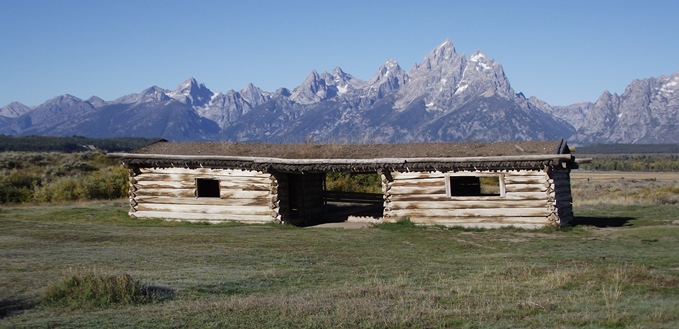
Sure, frontier life would've been tough. Harsh winters, summer droughts, wildfires, horse rustlers and vigilantes posing as lawmen were all part of daily life on the range. Right? But with those outstanding panoramic views of the Grand Tetons, you have to admit that those pioneers had a nice little slice of heaven in their own backyard!
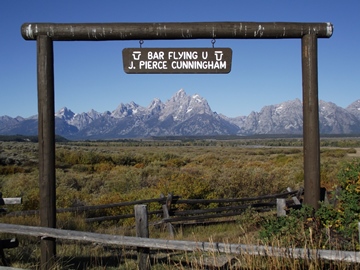 The Cunningham Cabin is one of the valley's few remaining structures from the homesteading era. After staking his claim for the Bar Flying U Ranch, John Cunningham built this cabin in 1888, and lived in it until completing his main residence in 1895. The original cabin, built in the Appalachian style (also commonly known as a "double-pen" or "dog-trot" style), would eventually become his smithy and barn.
The Cunningham Cabin is one of the valley's few remaining structures from the homesteading era. After staking his claim for the Bar Flying U Ranch, John Cunningham built this cabin in 1888, and lived in it until completing his main residence in 1895. The original cabin, built in the Appalachian style (also commonly known as a "double-pen" or "dog-trot" style), would eventually become his smithy and barn.
For the next 33 years John and his wife, Margaret, grew hay and raised cattle and sheep. By 1924 the Cunningham ranch had grown to 560 acres. However, the family left the valley for Idaho in 1928 when land was being acquired for the future Grand Teton National Park. The Cunningham's sold their ranch to the Snake River Land Company, a firm that was set-up by John D. Rockefeller, Jr. to purchase land from ranchers who fell on hard times, and then later donated to the U.S. Government to become part of the new national park.
In 1893 the cabin was the scene of a shootout between a small U.S. Marshal posse from Idaho, and two purported horse thieves who were killed at the scene. The two dead men, who had worked for Cunningham during the previous season, were buried in unmarked graves nearby. The men's guilt, the allegations, and the marshal's identity have never been confirmed.
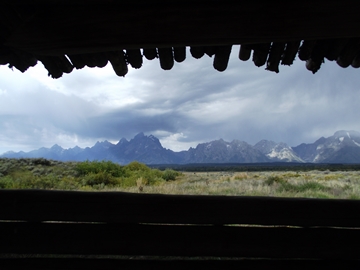 In 1973 the Cunningham Cabin ranch was added to the National Register of Historic Places. The historic site includes the original cabin, which is the only building that still remains. It measures roughly 41.5 feet by 15.25 feet, and has two rooms that open into a breezeway. The south room was the Cunningham's living quarters, while the north room was used as a forge.
In 1973 the Cunningham Cabin ranch was added to the National Register of Historic Places. The historic site includes the original cabin, which is the only building that still remains. It measures roughly 41.5 feet by 15.25 feet, and has two rooms that open into a breezeway. The south room was the Cunningham's living quarters, while the north room was used as a forge.
Visitors can easily reach the cabin, which is only a tenth-of-a-mile from the parking area. There are a couple of faint trails that visit the former sites of the old ranch house, barn, shed and other outbuildings. Although there's really not much to see anymore, visitors should still venture out onto the ranch grounds to appreciate the outstanding views the homesteaders were able to enjoy every day. Although the guide includes a trail map, the trails are very faint, and signage is non-existent. In total, the trail(s) meander for roughly a half-mile throughout the property.
My book, Ramble On (a history of hiking), contains an extensive section on the development of trails and hiking culture in America's first tourist destinations, national forests and national parks.
